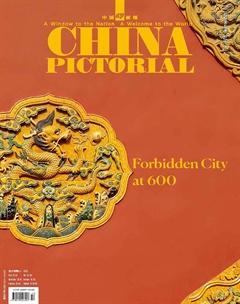Cut from the Same Block
by Liu Dejiang
As two nations separated by just a thin strip of ocean, China and Japan have exchanged culture and art for thousands of years. During the Ming (1368-1644) and Qing(1644-1911) dynasties, woodblock color prints reached maturity, which helped New Year woodblock paintings peak in the Qing Dynasty and contributed greatly to the rise and development of Japans Ukiyo-e.
The National Art Museum of China (NAMOC) recently hosted the“Woodblock Prints in Distinct Lands―Exhibition of Selected Fine Works from the NAMOC Collection of Japanese Ukiyo-e and Qing Dynasty New Year Woodblock Printing.”
The content of Qing Dynasty New Year woodblock prints was closely related to ordinary life. The bright and lively paintings recorded life in many realms, such as folk art to celebrate New Year and pray for good fortune. New Year pictures represent wishes for peace, happiness, wealth and auspiciousness, and depict an idealistic world.
Ukiyo-e is a genre of custom prints that emerged during Japans Edo Period (1603-1868) as a result of a highly developed civic culture. “Ukiyo-e” literally means “painting the vanity world,” which alludes to urging people to pursue happiness because life is short. The pictures depict urban life, various characters, and natural scenery, seeking to promote positive attitudes.
According to historical materials, Chinese woodblock paintings were probably introduced to Japan through Nagasaki alongside shipping goods, offering Japan a model for woodblock prints. Inspired by prints from the Ming Dynasty, Hishikawa Moronobu invented Ukiyo-e in the 1670s by making woodblock illustrations independent from books. Suzuki Harunobu invented Nishiki-e, or colorful Ukiyo-e, in 1765, using the multi-color printing technique.
Chinese New Year woodblock paintings and Japanese Ukiyo-e share many similarities. Historically, the popularity of the two forms of art benefited from social stability, development of the commodity economy, and the maturity of woodblock printing technology. In terms of their histories, the two developed almost in parallel, and both experienced a rise, boom and gradual decline between the 17th and 19th centuries. As for techniques, they were both influenced by Ming Dynasty woodblock prints in books and both can be reprinted. In terms of subject matters, they both reflect secular life, common thoughts and emotions, and richly capture folk customs. In terms of techniques, the rich and bright colors show characteristics of folk art, and the technique of filling with color after drawing lines shows characteristics of the horizontal decoration of Eastern art.
However, New Year woodblock paintings in the Qing Dynasty and Japanese Ukiyo-e differ in artistic styles and aesthetic taste. The former mostly served agricultural society with a warm and cheerful tone, reflecting the optimistic, open-minded and cheerful personality of the nation. The latter largely depicted brothel beauties, Kabuki, and natural scenery, demonstrating a gorgeous and slightly sentimental world of art, reflecting delicate, sensitive personalities, and open attitudes towards lifes desires. Whats more, there is a stark difference in global influence of the two genres, although they share the same origin.
In 1867, Japan began to fully integrate with the West and participated in the Exposition Universelle of 1900, where Ukiyo-e was displayed to Westerners when Western art was in an unprecedented crisis.The invention of the camera and drastic social changes had resulted in mounting difficulties for Western painting art. Confused Western artists were suddenly washed over by the simple lines and colors of Ukiyo-e paintings, which ignore precision in light and shade, brightness and shadow, and perspective. The Great Wave off Kanagawa by Katsushika Hokusai, for example, created a magical artistic style and strong visual impact with much simpler lines and colors compared to Western paintings. Western artists seemed to be suddenly enlightened, and they found inspiration from it.
The first Western artist to be inspired by Ukiyo-e cannot be identified, but the first to find big success with its influence must be French painter Manet. A Ukiyo-e samurai can be seen in the background of his Portrait of Emile Zola, next to an apparent print of Manets best work, Olympia. The painter gave up on the academic standards for fine light and shade, brightness and shadows, and perspective as well. Such inspiration continued among Western artists, all the way to Van Gogh, who had just arrived in Paris to practice. In March 1886, Van Gogh made a spur-of-the-moment trip from Antwerp to Paris. While in Paris, Van Gogh became intensely fascinated by Ukiyo-e. Nourished by impressionist art, which had drawn inspiration from Ukiyoe, Van Gogh became a Ukiyo-e collector. Van Gogh once wrote to another French painter, Monet, who was also a fan of Ukiyo-e, a letter to express his obsession with the art style. Ukiyo-e is widely known to have heavily influenced Van Goghs career. The influence of Ukiyo-e did not stop at Van Gogh, but spread through a larger crowd, becoming “Japanese doctrine” in Western art circles. The influence continued until the outbreak of World War I.
This exhibition was divided into four parts: “From a Common Origin to Different Genres,” “Images and Styles,” “Craftsmanship and Audience,”and “Production and Distribution.”Similarities between Ukiyo-e and Qing Dynasty New Year woodblock painting styles are catalogued as well as their differences in aesthetics, mentality, and national spirit.

